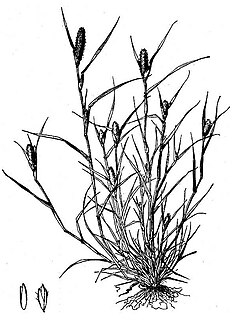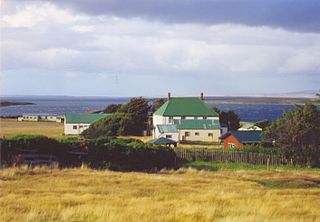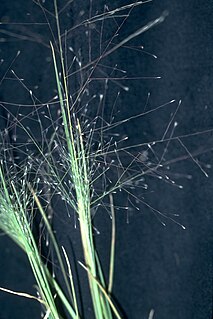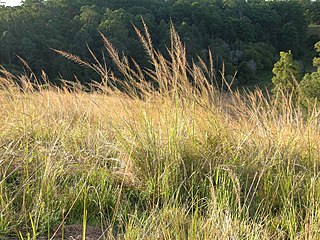
Sporobolus anglicus is a species of cordgrass that originated in southern England in about 1870 and is a neonative species in Britain. It was reclassified as Sporobolus anglicus after a taxonomic revision in 2014, but Spartina anglica is still in common usage. It is an allotetraploid species derived from the hybrid Sporobolus × townsendii, which arose when the European native cordgrass Sporobolus maritimus hybridised with the introduced American Sporobolus alterniflorus.

Sporobolus heterolepis, commonly known as prairie dropseed, is a species of prairie grass native to the tallgrass and mixed grass prairies of central North America from Texas to southern Canada. It is also found further east, to the Atlantic coast of the United States and Canada, but is much less common beyond the Great Plains and is restricted to specialized habitats. It is found in 27 states and four Canadian provinces.
Holochilus chacarius, also known as the Chacoan marsh rat or Chaco marsh rat, is a semiaquatic rodent species in the family Cricetidae. It is found in Argentina and Paraguay within the Gran Chaco.

The round-tailed muskrat is a species of rodent in the family Cricetidae, sometimes called the Florida water rat. The species is monotypic in the genus Neofiber. It is found only in the southeastern United States, where its natural habitat is swamps.

Sporobolus is a nearly cosmopolitan genus of plants in the grass family. The name Sporobolus means "seed-thrower", and is derived from Ancient Greek word σπόρος (spóros), meaning "seed", and the root of βάλλειν (bállein) "to throw", referring to the dispersion of seeds. Members of the genus are usually called dropseeds or sacaton grasses. They are typical prairie and savanna plants, occurring in other types of open habitat in warmer climates. At least one species is threatened with extinction, and another is extinct.

The banner-tailed kangaroo rat is a species of rodent in the family Heteromyidae. It is found in arid environments in the southwestern United States and Mexico where it lives in a burrow by day and forages for seeds and plant matter by night.

Crypsis is an African and Eurasian plant in the grass family sometimes referred to as pricklegrass.

Tussock grasses or bunch grasses are a group of grass species in the family Poaceae. They usually grow as singular plants in clumps, tufts, hummocks, or bunches, rather than forming a sod or lawn, in meadows, grasslands, and prairies. As perennial plants, most species live more than one season. Tussock grasses are often found as forage in pastures and ornamental grasses in gardens.

Sporobolus virginicus, known by numerous common names including seashore dropseed, marine couch, sand couch, salt couch grass, saltwater couch, coastal rat-tail grass, and nioaka, is a species of grass with a wide distribution.

The Ascension scrub and grasslands ecoregion covers the dormant volcano, Ascension Island in the Atlantic Ocean. As well as shrubs and grasses wildlife on the island includes a range of unique flora and fauna. In particular the surrounding islets are important havens for many seabirds, although the seabird populations on Ascension island itself have been severely affected by introduced species, particularly cats.

Muhlenbergia asperifolia is a species of grass known as alkali muhly and scratchgrass. It is native to much of North America, including most of southern Canada, most of the continental United States except for the southeastern region, and parts of northern Mexico. It also grows in South America.

Sporobolus foliosus is a species of grass known by the common name California cordgrass. It was reclassified from Spartina foliosa after a taxonomic revision in 2014. It is native to the salt marshes and mudflats of coastal California and Baja California, especially San Francisco Bay. It is a perennial grass growing from short rhizomes. It produces single stems or clumps of thick, fleshy stems that grow up to 1.5 meters tall. They are green or purple-tinged. The long, narrow leaves are flat or rolled inward. The inflorescence is a narrow, dense, spike-like stick of branches appressed together, the unit reaching up to 25 centimeters long. The lower spikelets are sometimes enclosed in the basal sheaths of upper leaves.

Sporobolus airoides is a species of grass known by the common name alkali sacaton. It is native to western North America, including the Western United States west of the Mississippi River, British Columbia and Alberta in Canada, and northern and central Mexico. It grows in many types of habitat, often in alkali soils, such as in California desert regions.

Sporobolus cryptandrus is a species of grass known as sand dropseed. It is native to North America, where it is widespread in southern Canada, most of the United States, and northern Mexico.
Sporobolus flexuosus is a species of grass known by the common name mesa dropseed. It is native to western North America, where it can be found in the deserts and woodlands of the Southwestern United States and Northern Mexico.

Sporobolus indicus is a species of grass known by the common name smut grass.

Sporobolus vaginiflorus is a species of grass known by the common names poverty grass, poverty dropseed, and sheathed dropseed.

Sporobolus spicatus, also known as salt grass, is a halophyte.

Sporobolus junceus is a species of grass known by the common name pineywoods dropseed. It is native to the southern United States.

Sporobolus pyramidalis, commonly known as giant rat's tail grass, is a species of grass native to Africa and Yemen. It has become a weed in eastern Australia.

















